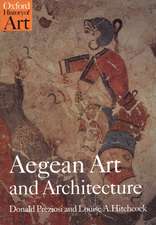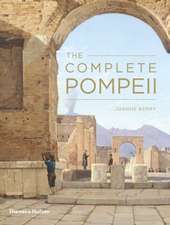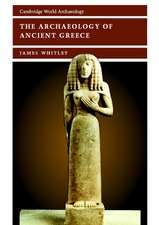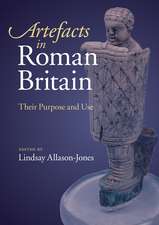Masterpieces of Greek Sculpture: A Series of Essays on the History of Art: Cambridge Library Collection - Archaeology
Autor Adolf Furtwängler Eugenie Strongen Limba Engleză Paperback – 25 aug 2010
Din seria Cambridge Library Collection - Archaeology
- 19%
 Preț: 608.32 lei
Preț: 608.32 lei - 19%
 Preț: 551.86 lei
Preț: 551.86 lei - 23%
 Preț: 721.86 lei
Preț: 721.86 lei - 19%
 Preț: 565.75 lei
Preț: 565.75 lei - 19%
 Preț: 609.42 lei
Preț: 609.42 lei - 19%
 Preț: 643.23 lei
Preț: 643.23 lei -
 Preț: 171.11 lei
Preț: 171.11 lei -
 Preț: 291.51 lei
Preț: 291.51 lei - 11%
 Preț: 421.61 lei
Preț: 421.61 lei -
 Preț: 418.13 lei
Preț: 418.13 lei -
 Preț: 520.59 lei
Preț: 520.59 lei -
 Preț: 278.43 lei
Preț: 278.43 lei -
 Preț: 240.89 lei
Preț: 240.89 lei -
 Preț: 538.11 lei
Preț: 538.11 lei -
 Preț: 468.48 lei
Preț: 468.48 lei -
 Preț: 331.70 lei
Preț: 331.70 lei -
 Preț: 223.02 lei
Preț: 223.02 lei -
 Preț: 464.99 lei
Preț: 464.99 lei -
 Preț: 448.80 lei
Preț: 448.80 lei -
 Preț: 367.12 lei
Preț: 367.12 lei - 19%
 Preț: 460.29 lei
Preț: 460.29 lei -
 Preț: 378.37 lei
Preț: 378.37 lei -
 Preț: 522.93 lei
Preț: 522.93 lei -
 Preț: 467.51 lei
Preț: 467.51 lei -
 Preț: 370.98 lei
Preț: 370.98 lei -
 Preț: 469.04 lei
Preț: 469.04 lei -
 Preț: 222.41 lei
Preț: 222.41 lei -
 Preț: 279.79 lei
Preț: 279.79 lei -
 Preț: 281.48 lei
Preț: 281.48 lei -
 Preț: 466.53 lei
Preț: 466.53 lei -
 Preț: 367.54 lei
Preț: 367.54 lei -
 Preț: 420.27 lei
Preț: 420.27 lei -
 Preț: 519.83 lei
Preț: 519.83 lei -
 Preț: 379.25 lei
Preț: 379.25 lei -
 Preț: 369.62 lei
Preț: 369.62 lei -
 Preț: 227.04 lei
Preț: 227.04 lei - 19%
 Preț: 575.80 lei
Preț: 575.80 lei -
 Preț: 376.64 lei
Preț: 376.64 lei -
 Preț: 221.64 lei
Preț: 221.64 lei -
 Preț: 523.09 lei
Preț: 523.09 lei -
 Preț: 474.33 lei
Preț: 474.33 lei
Preț: 508.99 lei
Preț vechi: 628.38 lei
-19% Nou
Puncte Express: 763
Preț estimativ în valută:
97.41€ • 105.77$ • 81.82£
97.41€ • 105.77$ • 81.82£
Carte tipărită la comandă
Livrare economică 22 aprilie-06 mai
Preluare comenzi: 021 569.72.76
Specificații
ISBN-13: 9781108017121
ISBN-10: 1108017126
Pagini: 552
Ilustrații: 216 b/w illus.
Dimensiuni: 210 x 297 x 28 mm
Greutate: 1.31 kg
Editura: Cambridge University Press
Colecția Cambridge University Press
Seria Cambridge Library Collection - Archaeology
Locul publicării:Cambridge, United Kingdom
ISBN-10: 1108017126
Pagini: 552
Ilustrații: 216 b/w illus.
Dimensiuni: 210 x 297 x 28 mm
Greutate: 1.31 kg
Editura: Cambridge University Press
Colecția Cambridge University Press
Seria Cambridge Library Collection - Archaeology
Locul publicării:Cambridge, United Kingdom
Cuprins
Author's preface; Editor's preface; Part I. Pheidias: 1. Discovery of the Lemnian Athena; 2. Site of the Lemnia on the Akropolis; 3. Comparison between Lemnia and Parthenos; 4. Analysis of the Lemnia; 5. Drapery and pose of the Lemnia; 6. Monuments related to Lemnia and to Parthenos; 7. The Olympian Zeus; 8. Other works related to the Lemnia; 9. Pheidias and his pupils, Alkamenes and Agorakritos; 10. The Dioscuri of Monte Cavallo, and the elder Praxiteles; 11. Pheidian influences in Sicily and Magna Graecia; Part II. Kresilas and Myron: 1. Literary and epigraphical evidence for the life of Kresilas; 2. The portrait of Perikles; 3. The Diitrephes; 5. The Amazon; 6. The Diomede; 7. The Medusa Rondanini; 8. Statue of an athlete at Petworth; 9. Relation of Kresilas to Myron; 10. Statues by Myron; 11. The 'Cassel Apollo'; 12. The Perseus; 13. Myronian female head; 14. The Munich Zeus and the first Aegive School; Part III. Polykleitos: 1. Historical and epigraphical evidence; 2. The Doryphoros; 3. The Diadumenos; 4. The Amazon; 5. The basis of the statue of Kyniskos; 6. The basis of the statue of Pythokles; 7. The basis of the statue of Xenokles; 8. The basis of the statue of Aristion; Skopas. Praxiteles. Euphranor: 1. Skopas; 2. Praxiteles; 3. Euphranor; Part IV. The Venus of Milo: 1. The lost inscribed fragment; 2. Restoration of the statue; 3. Influences that affected the artist of the 'Venus': The Apollo of the Belvedere; Appendix - the Temples of Athena on the Akropolis; Index.
Descriere
The influential study of Greek and Roman sculpture which introduced the Kopienkritic approach to the study of classical art history.










